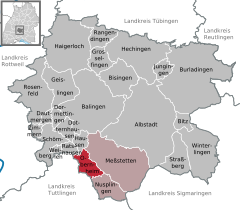Obernheim


Obernheim is a municipality of the Zollernalbkreis district of Baden-Württemberg, Germany.
History
Obernheim became a possession of the Kingdom of Württemberg in 1805 and was assigned to Oberamt Balingen [de]. Five years later, in 1810, it was reassigned to Oberamt Spaichingen [de], which was merged into Landkreis Balingen [de] in 1938. Obernheim grew and industrialized after the Second World War, first expanding in the 1950s to the north-east and west, and then in the 1970s to the north once more. As part of the 1973 Baden-Württemberg district reform [de], Landkreis Balingen was dissolved and Obernheim was assigned to the newly-created Zollernalb district. There was further municipal growth to the northeast in the 1980s and 1990s.[3]
Geography
The municipality (Gemeinde) of Obernheimof is located along the southern edge Zollernalb district of Baden-Württemberg, one of the Federal Republic of Germany's 16 States. It lies along the border with Tuttlingen district and the western edge of the Kuppenalb [de], between the Upper and Lower Bära rivers, in the High Swabian Jura [de]. Elevation above sea level ranges in the municipality from a high of 988 meters (3,241 ft) Normalnull (NN) to a low of 751 meters (2,464 ft) NN.[3]
A portion of the Federally-protected Stromelsberg-Hessenbühl [de] nature reserve is located in Obernheim's municipal area.[3]
Demographics
Population development:[4]
|
Coat of arms
Obernheim's coat of arms is a field of white crossed by a single blue bar. This pattern was adapted from the personal blazon of Johann von Obernheim, a local 14th century nobleman, and was approved for official use by the provisional post-WWII Württemberg-Hohenzollern government on 27 October 1950. A corresponding flag was issued on 15 January 1982.[3]
Transportation
Obernheim was connected to the Heuberg Railway until its station was closed in 1996. Local public transportation is provided by the Verkehrsverbund Neckar-Alb-Donau [de].[3]
References
- ^ Aktuelle Wahlergebnisse, Staatsanzeiger, accessed 15 September 2021.
- ^ "Bevölkerung nach Nationalität und Geschlecht am 31. Dezember 2022" [Population by nationality and sex as of December 31, 2022] (CSV) (in German). Statistisches Landesamt Baden-Württemberg. June 2023.
- ^ a b c d e "Nusplingen". LEO-BW (in German). Baden-Württemberg. Retrieved 17 July 2020.
- ^ "Obernheim (Zollernalbkreis, Baden-Württemberg, Deutschland) - Einwohnerzahlen, Grafiken, Karte, Lage, Wetter und Web-Informationen". citypopulation.de. Retrieved 2023-12-07.
External links
- Official website
 (in German)
(in German)











